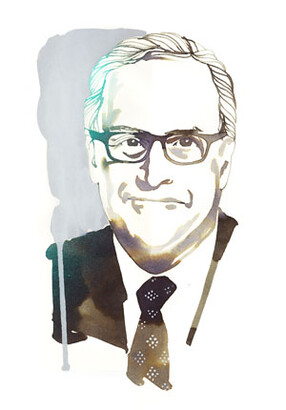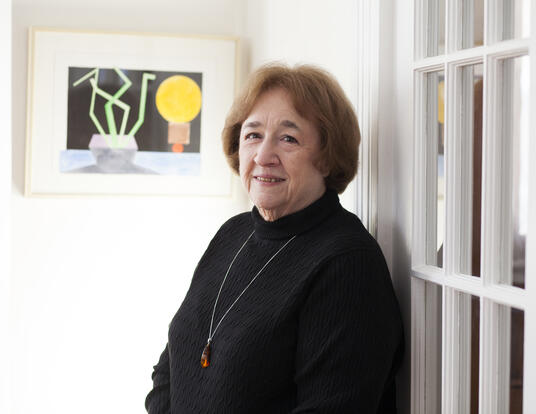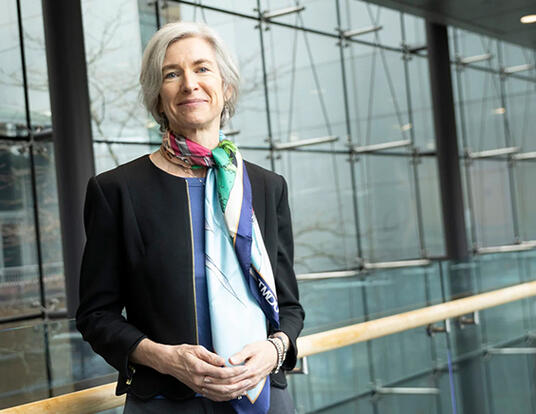A Conversation with John Lechleiter
From the bench to the corner office, the Eli Lilly CEO talks patents, R&D, and the thrill of laboratory science

John C. Lechleiter, PhD ’80, chemistry and chemical biology, is chairman, president, and chief executive officer of Eli Lilly and Company, the pharmaceutical giant based in Indianapolis. He started at Lilly as a bench scientist in 1979, and over time became an industry leader and a strong voice in emerging conversations about the necessity of innovation, the revolution in biomedical science, and the need for regulatory, tax, and immigration policies that encourage and sustain an innovative economy. Even as Lilly faces the business challenges posed by a colliding series of patent expirations on several successful drugs, including the schizophrenia drug Zyprexa and the antidepressant Cymbalta, Lechleiter is optimistic about the unprecedented potential of research in the life sciences to improve health and drive the economy.
He spoke with Colloquy, the GSAS alumni magazine.
You’ve spent your entire career at Eli Lilly. Describe your path.
I started at Lilly as a bench chemist, doing chemistry in our process development area. These were the chemists and engineers that really came up with the methodology that enabled us to make these medicines in a manufacturing plant. I was happy to have a job, a good job with a good company, and I didn’t conceive of any sort of opportunity beyond that. Eventually, I had to deal with the opportunity presented to me to essentially leave the laboratory and take a management position within the R&D division. And that was a tough decision. That was a real career change. I knew that even if it was theoretically possible to go back in the other direction, it probably wasn’t practical. So I felt like I was leaving behind something I really enjoyed doing and something I was pretty good at. But at the same time, I think I took with me a knowledge base and some general principles that have served me well in management.
Say more about the principles you’ve carried from the bench to the corner office.
I think that the pursuit of a PhD is itself a discipline — it teaches one a certain discipline around generating a hypothesis, bringing together various streams of data and knowledge, and in essence answering the question, Can we make this molecule? Or can we develop new ways of doing chemistry to make molecules in general?
I think that that orientation and that rigor is something that does carry over to the way someone in my position today — a CEO, a business manager — might think about approaching problems and organizing their thinking and generating alternative hypotheses — being willing to take a different view of something in order to come up with the best answer. I never thought of my PhD as preparing me for a broader pursuit like the one I’m currently doing, but in hindsight, it was excellent preparation.
Any thoughts on the role of the PhD in industry?
“Most kids start off being curious — about how this works, why that happens — and somewhere along the line, we drag it out of them. . . . K-12 education is this country’s Achilles’ heel right now, and we’ve got to work collectively to solve that problem.” — John Lechleiter
Today, the success of any enterprise — and I’ll use Lilly as a point of reference — is much more a function of operating effectively within a broad, global network. The Lilly that I joined in the late 1970s was, like a lot of companies, rather self-contained, perhaps a little inwardly focused. Today, with the explosion of knowledge and communication technologies, we recognize that to be successful, Lilly employees need to be knowledge seekers within this broad network. They have to be able to collaborate with people both inside and outside the company. They need to be able to take advantage of and seize on the opportunities created by knowledge, wherever it might originate.
That knowledge seeking, that ability to put various streams of knowledge together, and even some of the networking are important attributes of most PhD programs. There is no question that a PhD is still very relevant and, I think, increasingly necessary for one to be successful at a high level in any endeavor, certainly not excluding industry, or the business sector.
How essential are connections between industry and the academy?
I think effective working relationships between the private sector and the academic sector have grown enormously since the time when I was in graduate school. In the past, it might have been more of a quid pro quo: we will pay the university to get this body of work done through some channel that we may find useful, or we will support a graduate fellowship because we tend to hire people who come out of this university. There’s a much broader platform for collaboration today, as academic researchers consider the potential commercial application of some of their work, and as industry seeks new channels and new sources for innovative thinking and new ideas. I think the collaboration can go further still, particularly as we think about the biomedical sector. I would go so far as to say that our success at Eli Lilly depends on effective collaboration with academic researchers as well as with clinical researchers.
Is there anything in place?
We have developed something called an open innovation platform. About 200 institutions are partners with us in this, biotech companies or academic institutions. They will submit molecules or compounds to us, and we will screen those free of charge to see if they show any activity, at least in a model system, against various diseases or biological pathways. Then we provide a data report back to the submitter free of charge. The upside for us is that if we see something we’re interested in, there may be an opportunity for collaboration, and we like to have the first right of negotiation. But if we can’t negotiate a collaboration, the researchers are free to use that data in any way they choose. They own that information, they can write grant proposals or file patents, whatever they want to do.
But I think there’s much more opportunity, and it’s going to take both industry and academia to give and concede a little bit on occasion to make sure that some of the traditional barriers and concerns that might have kept us from working together can get managed and resolved.
Talk about guiding Lilly through upcoming patent expirations.

Well, we face a very challenging period in our history. I wish I could spread these patent expirations out a bit, but as it turns out we’ve got a few that will hit us 1, 2, 3 in the next few years. It will be a short-term negative for us, and unfortunately, in the business we’re in, it’s not like ordering up a new chicken sandwich to replace the Big Mac at the drive-through window. The timing of some of these breakthroughs is very difficult to predict. We’ve got a great, robust pipeline, the strongest pipeline in our history, but the molecules — the new medicines — are not going to start coming out of that pipeline until the end of this patent period.
So we’ve said, hey, we’re going to ride it out, generate the cash we need to pay the dividend and fund our research, and make the capital investments we need. But we’re not going to skimp on the investment necessary to realize what we think is the outstanding promise of the pipeline that we currently have. I think it would be a big mistake for Lilly to cut back on its traditional strong investment in R&D — notwithstanding criticism that has been leveled in various quarters about the fact that the industry has not been particularly productive in the last 10 years, as measured by the output of new drugs relative to the investments that we’ve made.
I think we’ve got to be careful there. We’re obviously investing to get a return on investment, not to throw money at R&D. But I also don’t want to let the past predict the future. This industry, over a long period of time, has gone through cycles, and I think right now we’re on the verge of really harnessing this breakthrough in knowledge of fundamental science, of human biology, that we’ve been seeing. I think the best years for this industry and this company are still ahead of us.
Do you still get excited by the possibilities of science?
I do. I wander into our labs on occasion, and I let them take me through the story until I get to the point where I don’t understand what they’re talking about anymore. I can’t pretend to be current, but I can live vicariously through the 6,000 scientists working here at Lilly.
I got interested in science because of a couple of outstanding high school teachers. The next big step for me was a summer research program I did in 1974 at the University of Minnesota, which was the first time I got to do laboratory-based research. I’m a strong believer in those two aspects of science education, as we focus this country on increasing basic aptitude in science and math among grade school and high school students, and hopefully getting more of them interested in pursuing STEM-type careers. Great teachers and opportunities to do hands-on research are indispensible ingredients.
How can we encourage this?
One of the big focus areas for our Lilly Foundation has been to foster new approaches to teaching math and science in Indiana at the K-8 level, in order to give students opportunities to learn in a way that creates that energy and excitement that I think most scientists feel about the work they do. Most kids start off being curious — about how this works, why that happens — and somewhere along the line, we drag it out of them. It’s fun to learn about science — I don’t mind sitting in a classroom and learning about molecular orbitals or whatever turns chemists on. But what’s really fun is getting in a laboratory and doing an experiment and seeing how this stuff plays out in the real world. That’s when the light really comes on.
We know what we need to do. The question is, are we going to be able and willing to do it, and give enough kids, including kids who come from disadvantaged backgrounds, an opportunity to participate. K-12 education is this country’s Achilles’ heel right now, and we’ve got to work collectively to solve that problem.
Photo courtesy Eli Lilly
Illustration by Tina Berning/CWC International, Inc.
Get the Latest Updates
Join Our Newsletter
Subscribe to Colloquy Podcast
Simplecast Stitcher




